The AMD Trinity Review (A10-4600M): A New Hope
by Jarred Walton on May 15, 2012 12:00 AM ESTAMD Trinity Gaming Performance
After the 3DMark results, you might be wondering if Intel has finally caught up to AMD in terms of integrated graphics performance. The answer is…yes and no. Depending on the game, there are times where a fast Ivy Bridge CPU with HD 4000 will actually beat out Trinity; there are also times where Intel’s IGP really struggles to keep pace. The good news is that at least everyone is now onboard the DX11 bandwagon, and compatibility with games has improved yet again for Intel. Here are our “Value” benchmark results for seven recent games; we’ll have more information in a moment.

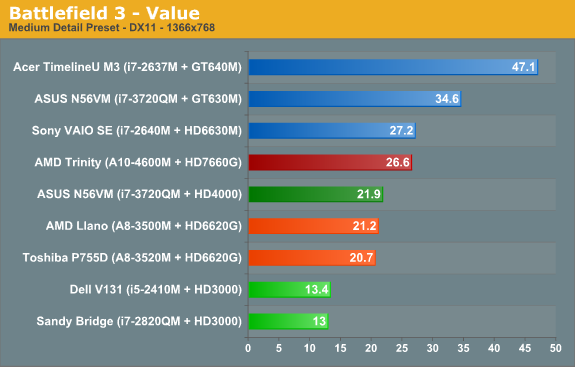
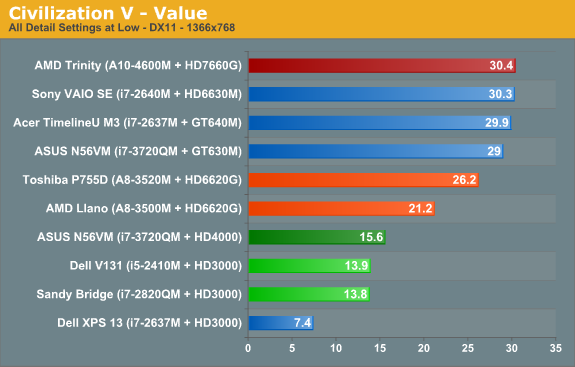

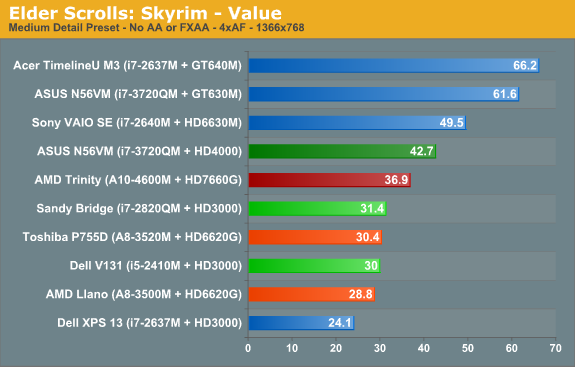
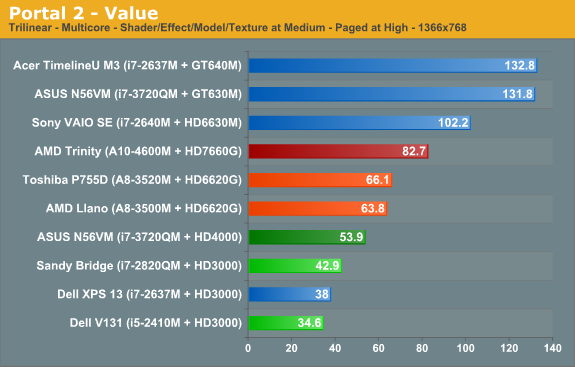
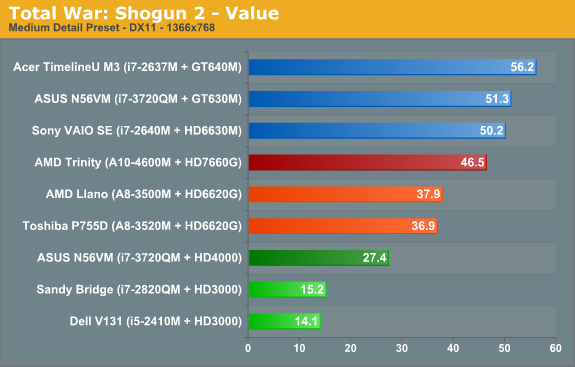
Out of our seven test titles, AMD’s Trinity leads any other IGP in four titles by a large margin. The other three titles actually have Ivy Bridge slightly ahead of Trinity, but the gaps aren’t nearly as big. Overall, the average performance across the seven games at our Value (medium) settings has AMD’s Trinity A10-4600M leading Intel’s i7-3720QM by 21%, and if we look at quad-core Sandy Bridge with HD 3000 (i7-2820QM) Trinity is 72% faster. Trinity is also around 20% faster than 35W Llano on average.
Let’s expand our gaming suite just a bit to see if things change, though. Just like we did with Ivy Bridge, we ran the eight games in our previous benchmark suite at medium detail settings. We can then compare performance across a wider 15 title selection to see how Trinity matches up against HD 4000, HD 3000, and HD 6620G (Llano). We’ll start with the bottom (HD 3000/Sandy Bridge) and move up.
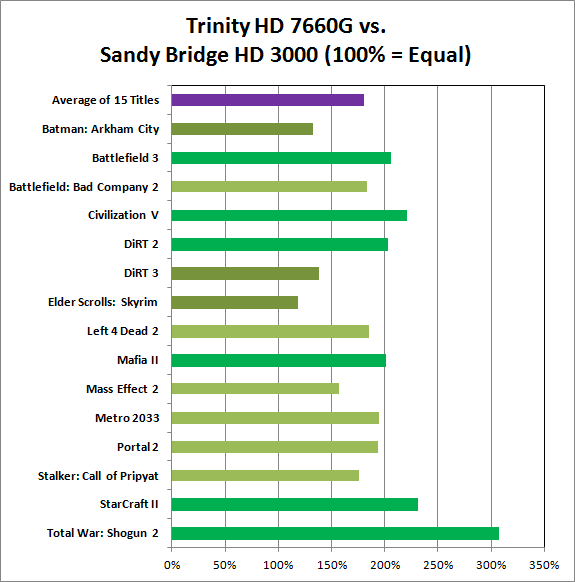
Llano’s HD 6620G was already faster than HD 3000, and Trinity’s HD 7660G is faster than Llano, so the Sandy Bridge gaming matchup is a landslide victory in AMD’s favor. The closest Intel can get is in the same three titles where Ivy Bridge leads Trinity: Batman: Arkham City, DiRT 3, and Skyrim. Here, however, HD 3000 can’t actually close the gap and HD 6620G is at least 20% faster than HD 3000, with an average performance improvement of nearly 80%.
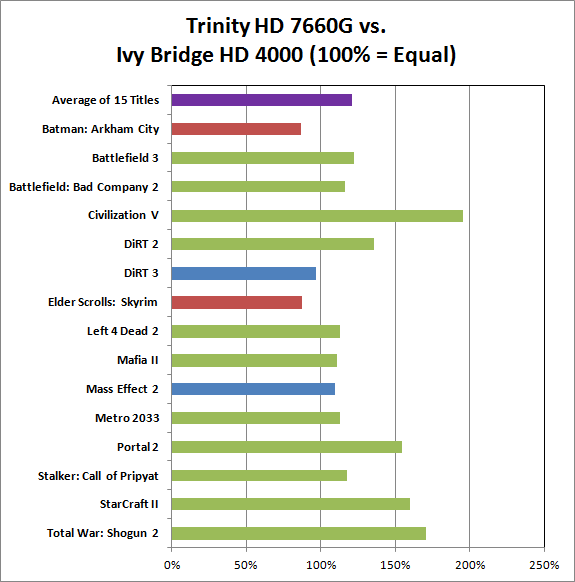
We found that across the same selection of 15 titles, Ivy Bridge and Llano actually ended up “tied”—Intel led in some games, AMD in others, but on average the two IGPs offered similar performance. This chart and the next chart will thus show a similar average increase in performance for Trinity, but the details in specific games are going to be different. Starting with Ivy Bridge and HD 4000, as with our earlier game charts we see there are some titles where Intel leads (Batman and Skyrim), a couple ties (DiRT 3 and Mass Effect 2), and the remainder of the games are faster on Trinity. Mafia II is close to our <10% “tie” range but comes in just above that mark, as do Left 4 Dead 2 and Metro 2033. The biggest gap is Civilization V, where Intel’s various IGPs have never managed good performance; Trinity is nearly twice as fast as Ivy Bridge in that title. Overall, it's a 20% lead for Trinity vs. quad-core Ivy Bridge.
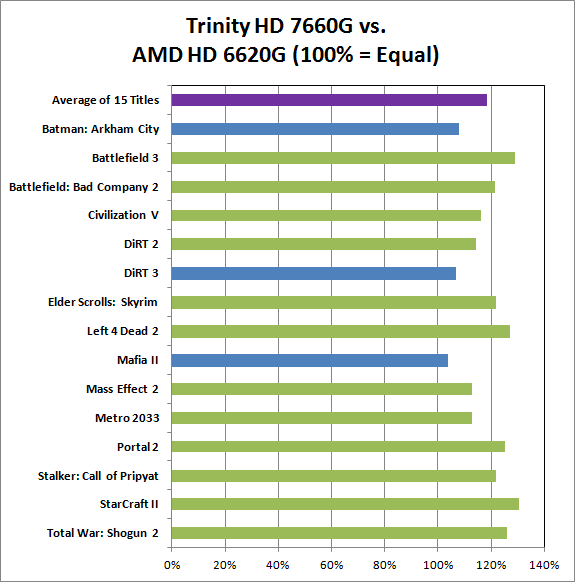
Against Llano, Trinity is universally faster, but the smallest gap is in Mafia II (3%) while the largest gap is in StarCraft II (30%). On average, looking at these games Trinity is only 18% faster than Llano. What’s not entirely clear from the above chart is whether we’re hitting CPU limitations, memory bandwidth limitations (remember that Llano and Trinity share bandwidth with the rest of the system), or perhaps both. At our chosen settings, what is clear is that Trinity’s “up to 56% faster” graphics never make it that high.
We saw 35-45% higher scores in 3DMark 11 and Vantage, which tend to remove the CPU from the equation more than actual games, so our guess would be that if AMD continues with their APU plan they’re going to need to work more on the CPU side of the equation. We also see the same thing looking at the VAIO SE scores in the earlier gaming charts: the HD 6630M scores are 20% faster on average, but much of that appears to come from the faster CPU rather than the GPU.










271 Comments
View All Comments
Khato - Tuesday, May 15, 2012 - link
Really? The A10-4600m is going to be a $126 chip? 'Cause that's what a third of the tray price for an i7-3720QM is.BSMonitor - Tuesday, May 15, 2012 - link
You get 1/3 the performance on the CPU side.bji - Tuesday, May 15, 2012 - link
I don't know why I am bothing to respond to you, because your comments are all worthless, but I'd like to point out to anyone else who might be reading, that the CPU performance numbers are alot closer to 1/2 to 2/3 of the performance on the CPU side than 1/3.And 1/2 to 2/3 of Ivy Bridge CPU performance is *definitely* fast enough for 95% of users in 95% of circumstances, despite what trolls are claiming.
bji - Tuesday, May 15, 2012 - link
Sorry, forget I said 2/3. That was just one benchmark. Let's just leave it at 1/2.I think my point is still valid. 1/2 of Ivy Bridge performance at 1/3 cost is going to be very acceptable to the vast majority of people.
JarredWalton - Tuesday, May 15, 2012 - link
But the problem is you have to buy the whole laptop. If IVB goes for $350 and Trinity for $115, but the rest of the laptop ends up being $400, that means you get half the performance for 70% of the cost. And when Intel ships DC IVB chips for $150, we might be looking at 70% of the performance for 90% of the cost.My biggest fear with Trinity (if you couldn't tell from the conclusion) is that the laptop OEMs will price it too high. I think A10 is a decent part, provided you can get a reasonable set of laptop hardware for $600 or less. Anyway, we'll have to see what actually comes out and how much it costs.
bji - Tuesday, May 15, 2012 - link
Very good points. Then we have to throw in the question of how much the extra performance is worth to the user. We'd all take extra performance for free (assuming that it didn't come at a cost of heat or battery life or other features), but would you pay 10% more for more performance that you knew you didn't need? I don't think most consumers really think in these terms of course, marketing will sell these parts, not logic, but if we're trying to make price and value comparisons, we need to be aware that the goal is to get what you need for the least money, not more than you need for the least amount more money.JarredWalton - Tuesday, May 15, 2012 - link
I'd take Trinity with an SSD over Sandy Bridge with an HDD, provided I could get a good LCD and build quality thrown into the mix. Maybe HP will deliver with the upcoming Envy Sleekbooks?mrdude - Tuesday, May 15, 2012 - link
HP offered this with the Llano, granted they charge $150 for a 1080p screen... You can also opt to buy an aftermarket 1080p screen and DIY. The Asus Llano line was extremely popular because you can buy a $70 1080p matte finish screen and upgrade a crossfired Llano. For ~$600 you got great gaming performance and a 1080p screen. Those things sold like hotcakes too.Jarred, I think you neglected quite a bit in this review. The improvements we've seen in Llano > Trinity actually outweigh the improvements we've seen in SB > Ivy yet the latter also has the advantage of a die shrink. The perf-per-watt improvements are by far the biggest shocker here and are nothing short of unbelievable if you consider Bulldozer's power consumption.
While I understand using the 3720QM for the HD4000 benchmarks, why not delve into examining the Piledriver cores? There's very little info at all there with respect to what changed and what got better. What we got instead were synthetic benchmarks and a re-cap of the scores instead of some actual info. Hell, a monkey can run a benchmark but can that monkey run some meaningful benchmarks that test cache latency? AVX performance? Stress the IMC?Instead you're stating something that should be obvious (the weird multi-threaded cinebench score that actually makes sense when you consider it's a CMT design in Trinity therefore it lacks 2 FPUs compared to Llano) and that's supposed to be surprising?
I can understand wanting to get a review out in time and giving us a rough idea of performance, but this is Anandtech. We expect a bit more than "these are the scores and these are the numbers. Onto the next benchmark."
Spunjji - Wednesday, May 16, 2012 - link
I hear this.mikato - Wednesday, May 16, 2012 - link
I agree too (though the monkey part was a bit much). Maybe we can see a more in depth analysis of results, similar to Anandtech's treatment of AMD's new architecture but with hard results leading the analysis.